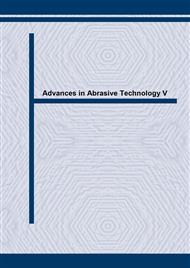[1]
Y. Wang: Grinding force models in finishing process, 2001 IEEE/ASME international conference on advanced intelligent mechatronics proceedings, Como, Italy, 2001, pp.822-887.
DOI: 10.1109/aim.2001.936772
Google Scholar
[2]
M. A. Elbestawi and K. M. Yuen: Adaptive force control for robotic disk grinding, CIRP, Vol. 40 (1991), No. 1, pp.391-394.
DOI: 10.1016/s0007-8506(07)62014-9
Google Scholar
[3]
T. Furukawa and D. C. Rye: Automated polishing of an unknown three-dimensional surface, Robotics & computer-integrated manufacturing, Vol. 12 (1996), No. 3, pp.261-270.
DOI: 10.1016/0736-5845(96)00004-x
Google Scholar
[4]
H. E. Jenkins and T. R. Kurfess: Design of a robust controller for a grinding system, IEEE transactional on control systems technology, Vol. 4 (1996), No. 1, pp.40-48.
Google Scholar
[5]
Z. Lu and Sadao Kauamura: Sliding mode impedance control and its application to grinding task, IEEE/RSJ international workshop on intelligent robots and systems, IROS'91, Japan, 1991, pp.350-355.
DOI: 10.1109/iros.1991.174475
Google Scholar
[6]
H. E. Jenkins and T. R. Kurfess: Optimization of real-time grinding process estimator, Proc ASPE 1995, 1995, pp.251-254.
Google Scholar
[7]
B. Ulrich, A. Srivastava, and M. Elbestawi: Analysis of the robotic disc grinding process, Int. J. Advanced manufacturing technology, Vol. 7 (1992), No. 2, pp.82-93.
DOI: 10.1007/bf02601574
Google Scholar
[8]
H. E. Jenkins, T.R. Kurfess, and R. C. Dorf: Design of a robust controller for a grinding system, Proc 3 rd IEEE conf. Control Application, Vol. 3 (1994), pp.1579-1584.
DOI: 10.1109/cca.1994.381481
Google Scholar
[9]
H. E. Jenkins and T. R. Kurfess: Adaptive pole-Zero cancellation in grinding force control, transactions on control systems technology, Vol. 7 (1999), No. 3, pp.363-369.
DOI: 10.1109/87.761056
Google Scholar
[10]
H. E. Jenkins and T. R. Kurfess: Design of a robust controller for a grinding system, IEEE transactions on control systems technology, Vol. 4 (1996), No. 1, pp.40-49.
DOI: 10.1109/87.481765
Google Scholar


